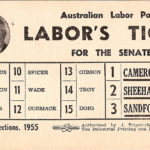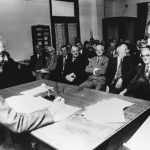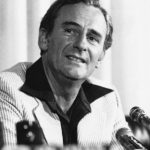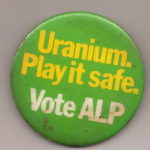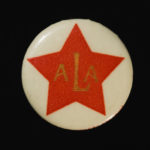Search Results
Colonial Origins
The prehistory of the Australian Labor Party can be traced well back into the 19th Century, notably with the beginnings of the trade union movement in mid-century and spasmodic attempts to give workers some representation…
Organisational Stresses
Although the Labor Party had been founded by the trade union movement, it very soon developed a life of its own, so that stresses between the party and unions were already evident in the 1890s.…
Socialists and Labor
Its trade union origins gave the new party its own distinct progressive character. Hence, the name of 'Labour' or 'Labor' party that was almost universally used, even when not the formal title, because it was…
A National Party
The early Labor Party had to identify its social base if it wanted to have continuing and improving electoral success. Obviously it made an appeal to trade unionists. However, most workers were not unionists at…
The First Federal Election
There was a significant problem for Labor in the first election in March 1901 after the party had opposed the terms of Federation in the referendums of the 1890s. Labor leaders had previously argued that the Australian…
The 1903 Election
Within a year after the first Federal election the Labor Party had settled in to national politics as an equal partner with the two fiscal parties. The game of party politics seemed the same as…
The Watson Labor Government
The answer was revealed within months. In the debate on the Government's Conciliation and Arbitration Bill, Deakin refused to accept a Labor amendment, and treated the ensuing vote (which was defeated by the combined votes…
Organisational Changes
With this new confidence came some organisational stiffening. Important decisions of the third Federal Conference in July 1905 amended the Fighting and General Platforms, and passed a number of resolutions aimed at directing Federal MPs,…

The Minority Fisher Labor Government
On the other side of politics the first Labor Party tenure of office had accelerated the pressures on the conservative parties to form some kind of fusion. The fiscal issue was not enough to form…
Majority Government
At the Federal election in April 1910 the fundamental issue was the reputation of both sides and a judgement about which was more likely to govern responsibly. Labor Party policy was presented as the unfinished…
The Great War
Early in 1914 the outbreak of the Great War seemed to promise a surge in Labor's fortunes. Most Labor spokesmen were committed to pursuing the war with a complete mobilisation of national effort. The election…
The Conscription Issue
After travelling to Britain early in 1916 Hughes returned home convinced that some form of conscription would be needed to provide the number of Australian troops demanded by British authorities. The Labor Party had always…
Aftermath and Rebuilding of Labor
In the Commonwealth Parliament the members of Caucus who remained in the Labor Party elected Frank Tudor as leader. Almost immediately he had to prepare for an election which was held in May 1917. Hughes…
Developments in the party system
While the conscription crisis of 1916-17 did great damage to the Labor Party, it also had a destructive impact on Australian society as a whole. Australia emerged from the war with the memory of contested…
Tensions and Reorganisation in the Party
Both the parliamentary party and the wider labour movement contributed to the process of healing the wounds of the recent split. Within Parliament the leadership of Caucus by Frank Tudor was directed at getting on…
Labor Reformism at the State Level
At a State level there were encouraging signs of revival. In an era before the Commonwealth was willing to take a leading role in social issues such as social welfare, education and health, much of…
Federal Intervention
New South Wales also provided another milestone in the history of the Federal ALP. When Premier Lang (exhibiting the other, much less attractive, side of his complex persona) presided over a split in the branch…
A New Party Leader
The nature of Federal politics changed after the 1922 election. For Labor, its two aspiring leaders had both died in office Ryan in 1921 and Tudor in 1922 leaving the way open for a fresh…
James Scullin and the 1929 Election
James Scullin had served his political apprenticeship as an organiser for the AWU and an opponent of conscription before he returned to Parliament in 1922 as the MP for the Victorian electorate of Yarra (he…
Dealing with the Depression: The Melbourne Agreement
Early measures to face rising unemployment involved increasing tariffs so as to bolster revenue, cutting off assisted immigration, abandoning the gold standard and offering some increases in social welfare. The first Budget of July 1930…
The Lang Plan and the Party Split
Returning to Sydney, Premier Jack Lang almost immediately repudiated the Melbourne Agreement, thus confronting the Federal Labor government. The most important ingredient of the subsequent 'Lang Plan' was that there should be a moratorium on…
Jack Lang and the Labor Party
Despite the expulsion of Lang's NSW Branch from the ALP, Lang retained control over the State machinery and the branch structure. More importantly, his populist appeal was much stronger than the Federal party's in the…
Social Divisions and the Experience of Trade Unions
During the 1930s Australia was affected more severely by the economic depression than most developed nations. Australia had depended almost completely on international trade which had now collapsed. Moreover, it was a deeply divided society.…
Rising International Tensions
By 1935, when John Curtin came to the leadership of the Federal ALP the worst of the Depression was over. There were still many unemployed workers, and the economy would not completely revive till after…
Coming to Power
When Curtin took over as leader his party was still deeply divided and crippled by the Lang influence in NSW, and also by ideological differences which made any firm decision especially on foreign affairs potentially…
Fighting the War
When Japan entered the war in December 1941 it was clear that Britain was not willing to divert extra resources to the Pacific. When two British warships, Prince of Wales and Repulse, were sunk by…
Planning for peace: The 1943 election
While Labor had come to power in 1941 with only the barest majority, depending upon the continued support of two Independents, the chaos in the Opposition parties meant that Curtin's government was fairly secure. Yet…

Ben Chifley: The man, his history and his values
Ben Chifley was one of Australia's most productive treasurers and prime ministers, helping to lead Australia successfully through the Second World War and the challenges of the early post-war years. Yet his path to the…
Sustaining the war economy
Ben Chifley’s experience as a minister in the Scullin government during the Depression, together with his time on the banking Royal Commission, provided good foundations for his role as Treasurer in the Curtin government. He…
Post-war reconstruction: Nation Building
Prior to becoming Treasurer in October 1941, Chifley had already turned his mind to post-war reconstruction and the expanded role that government would have to play if a better world was to emerge from the…
Implementing a Labor agenda
The Labor Party had won two resounding electoral victories in 1943 and 1946. The first victory rewarded Curtin’s government for its stewardship of the country during the dangerous months of 1942, while the second victory…
Conflict and the Cold War
Although Australia avoided invasion during the Second World War, Japan's frightening lunge southward, culminating in the fall of Singapore, confirmed the deep-seated fears of many Australians about the territorial ambitions of their northern neighbours. Those…
A Communist threat
Many Labor supporters were convinced that the electoral defeat of 1949 was just a temporary setback and that a strong Labor Government would quickly return to office in Canberra. Instead, that defeat inaugurated a 23-year…
The Grouper threat and the 1954 election
Organised opposition to Communist influence in trade unions had already begun in the late 1930s. Sections of the Catholic Church, especially in Melbourne, used the wider organisation of Catholic Action to set up a specific…
The DLP split
After the narrow defeat of Labor at the 1954 Federal elections, Dr. Evatt brought factional issues into the public arena by blaming the disloyalty of Groupers for his defeat. He demanded that the Federal Executive…
The 1961 election
When Dr Evatt was persuaded to step down as party leader in 1960, his replacement, Arthur Calwell, initially enjoyed considerable popular support. He had been a successful director of Australia's immigration policies in the Chifley…
Lessons of the Split
The socialist objective of the ALP, which had been modified a number of times in the past, most notably in 1921, was again tweaked to reflect the declining use of the term 'socialist' by members…
A changed world
A number of technological changes in the second half of the twentieth century brought about profound changes in both society and politics that had begun in the war. In 1956 the first regular transmissions of…
Modernising Labor, 1969 election
In his first electoral test of strength, a half Senate election at the end of 1967, Whitlam performed creditably against Prime Minister Holt although still falling short of winning. A more important pointer to his…
It’s Time. The 1972 election
The campaign for the election eventually called for December 1972 was the most professional, long running, and media orientated that Australia had seen to that date. It reflected the reorganisation of the party's extra-parliamentary machinery,…
The 1974 election
The problem for the new administration was getting legislation passed through the Senate as long as the Opposition did not recognise any electoral mandate for the Labor government. Meanwhile, the first year in office saw…
The dismissal and the 1975 election
By mid-1975 Malcolm Fraser determined that the economic management of the Whitlam government, and the alleged scandals of the loans affair, provided justification for using the Senate to deny supply to the government and force…
A revival under Hayden
Whitlam remained leader after the electoral defeat of 1975, having lost much of the backbench talent in that loss. He defended his program and attacked the government for dismantling it, but he could do little…
Signs in the States, The 1980 election
While the 1975 dismissal and the electoral defeat of the Whitlam government were crushing blows to Labor supporters, there were signs of hope at the state level. In South Australia the Dunstan government, in the…
Victory within sight
After the 1980 election Malcolm Fraser continued to lose support in the electorate. He had won three elections promising to manage the economy efficiently and bring back the good times, and he had not done…
The First Term
Bob Hawke was elected Federal Labor Leader and Opposition Leader, dramatically just as sitting Prime Minister Malcolm Fraser called a double-dissolution election campaign. Hawke campaigned with energy and confidence, expanding Bill Hayden’s strategy for Recovery…
The Second Term
In the lead-up to the election, Labor had made two significant commitments in economic management. First, budget discipline would be framed by what Hawke called the ‘Trilogy’: that is, there would be no increase in…
The Baton is changed
The Australian Labor Party celebrated its centenary in June 1991 at a national conference in Hobart. It pledged itself to hold a referendum, before the centenary of Federation, to make Australia a republic, and to…
The fifth term
Claiming victory on election night at Bankstown, a jubilant Keating declared it was ‘the sweetest victory of all – one for the true believers.’ Labor supporters rejoiced, while Coalition strategists and media doomsayers ate their…
The 1987 Campaign
Labor prepared for the 1987 election campaign on three major policy fronts. First, having already nominated Stage 2 of the Kakadu National Park for World Heritage listing, Labor burnished its environmental credentials with new initiatives.…
The third term
Immediately after the election, Hawke restructured the Commonwealth public service, amalgamating smaller ministries into ‘super’ departments covering larger portfolio areas. This yielded administrative efficiencies by reducing the total number of separate departments (from 27 to…
The fourth term
Labor’s new term in office was overshadowed by a protracted economic slowdown and the culmination of the leadership struggle between the Prime Minister and Treasurer. While the Reserve Bank cut interest rates in April, August…
1940 Jubilee article on Labor’s future
[pdfviewer]http://laborhistory.org.au/wp-content/uploads/2017/04/1940_alp_jubilee_future_paul_mortimer.pdf[/pdfviewer]
ALP 1927 Proposals for the Better Consolidation of the ALP
ALP 1927 Proposals for the Better Consolidation of the ALP
NAA 1949 Coal Strike Unions Against Correspondence
NAA 1949 Coal Strike Unions Against Corrrespondence

ALP 1977 Neville Wran endorsement
ALP 1977 Neville Wran endorsement Labor utilised its state based talent to promote its policies in the 1977 election.

Referendum ad ‘This Freedom’
Labor went to the people in 1944 seeking to change the constitution to better enable the federal government to rebuild Australia after the war. This ad shows Labor attacking the hypocrisy of the opposition. SOURCE:…

First Meeting of the Australian Labour Federation Qld
The First General Council meeting of the Australian Labor Federation, held in Brisbane on August 1st, 1890. SOURCE: Australian Labor Party View this image in Flickr for more sizes and to download.

Strikers Library in Barcaldine
The striking shearers maintained a sense of civilisation in their camps, which included the construction of a library to keep the shearers entertained and continue the worker's education that was supported by the union. SOURCE:…
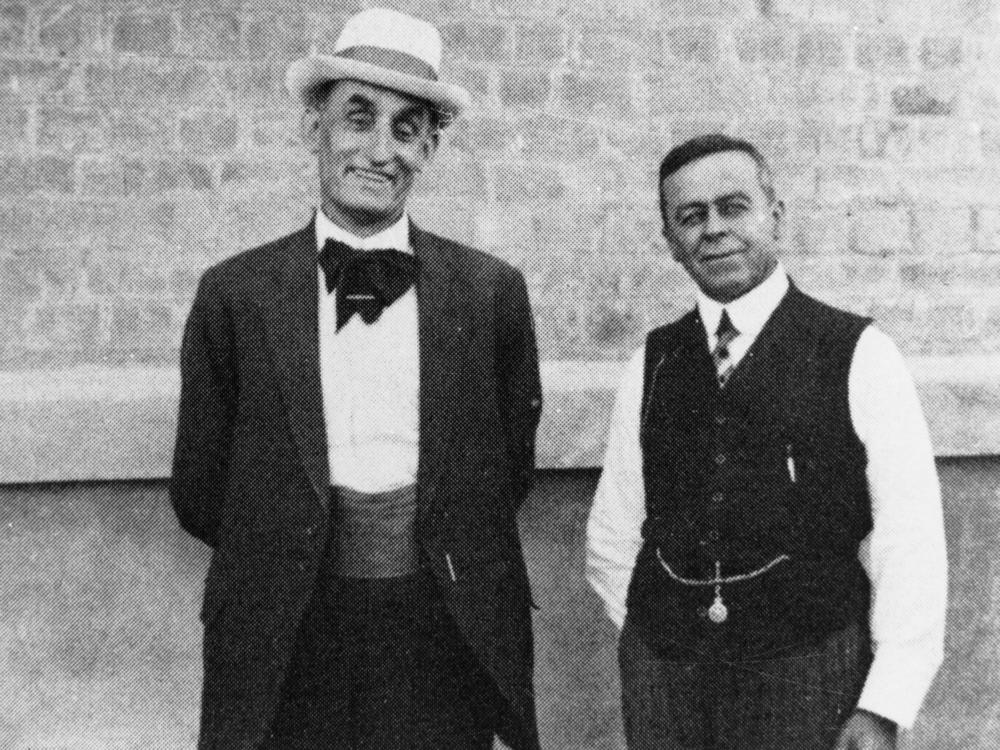
Henry Boote & Albert Hinchcliffe
Henry Boote & Albert Hinchcliffe were very active labor orgnaisers and agitators in Queensland during the 1890s. Boote was a journalist and Albert ws a long-term MLA. SOURCE: Australian Labor Party View this image in…

Anderson Dawson
Anderson Dawson was the very first leader of a Labor government in the world, becoming Queensland Premier in 1899. SOURCE: Australian Labor Party View this image in Flickr for more sizes and to download.

First Labor Government
It was the first elected Labor government in the world. Queensland Labor formed government in 1899, for only five days. View this image in Flickr for more sizes and to download.
Welcome
The Australian Labor Party is the great ‘party of initiative’ in Australian life. Since before Australia federated, our campaigns and governments have been marked by the struggle for change. The Chifley Research Centre is honoured…
Fmr. Senator John Faulkner
The Australian Labor Party is Australia's oldest political party. Our state branches are older than the nation; our Federal Parliamentary Labor Party was formed at a meeting the day before the Australian Commonwealth Parliament's first…
NLA 1891 Striking Shearers
The prehistory of the Australian Labor Party can be traced back into the 19th Century, notably with the beginnings of the trade union movement in mid-century and spasmodic attempts to give workers some representation in…
ALP 1899 First Queensland Labor Government 2
The prehistory of the Australian Labor Party can be traced well back into the 19th Century, notably with the beginnings of the trade union movement in mid-century and spasmodic attempts to give workers some representation…


























